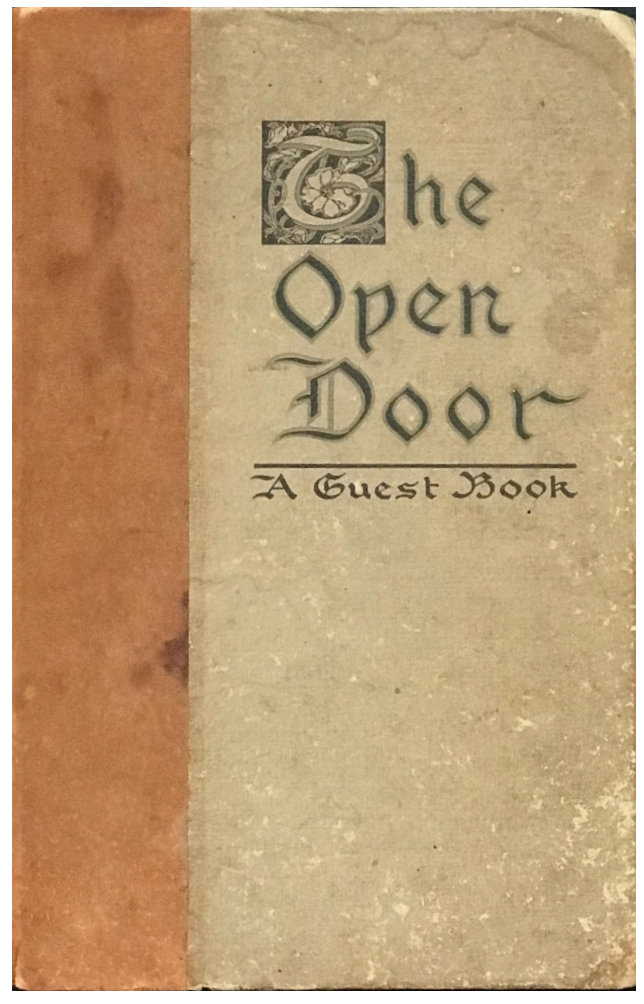 Cover of "The Open Door," Catherine Sheild's guest book for her Yorktown home. Image courtesy of the Yorktown Preservation Society.
Cover of "The Open Door," Catherine Sheild's guest book for her Yorktown home. Image courtesy of the Yorktown Preservation Society.For thirty years, Catherine Morris Stryker Sheild kept a guest book at her home in Yorktown, Virginia. Names, both well known and unknown, line the pages of this book, a copy of which is housed with the Yorktown Preservation Society, which was originally a branch of the Association for the Preservation of Virginia Antiquities that Sheild founded in 1921.
Bill Cole ’70, alumnus and innkeeper at the York River Inn Bed and Breakfast, shares the stories behind some of these names, weaving together personal narratives that touch upon Yorktown’s role in World War I, the hardships of the influenza pandemic, and the personal lives of U.S. presidents.
Conway Howard and Catherine Morris Stryker Sheild purchased their home on Main Street in Yorktown, Virginia in 1901. (Their son, Conway Sheild, Jr., and his three daughters, all attended William & Mary.) Beginning in 1915, Mrs. Sheild kept a guestbook with the last entry in 1945, just 7 months before her death in 1946. During that time, several hundred people visited and signed the book, including four men who were or became U.S. presidents, and 550 other people, some known and some unknown.
Edith Tunis Sale, an author of books on Virginia homes and gardens, commented in her 1927 volume Interiors of Virginia Houses of Colonial Times, which includes the Sheild home:
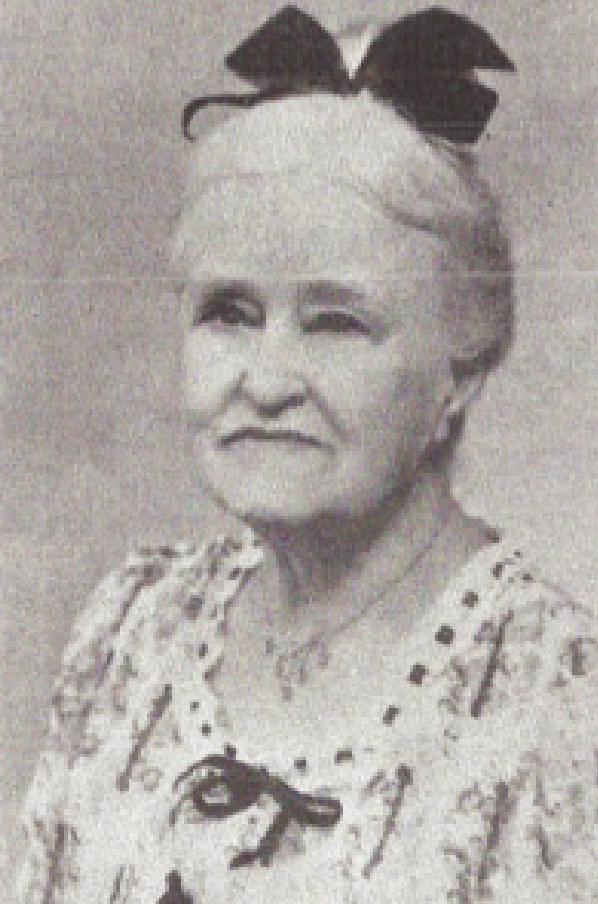 Catherine Morris Stryker Sheild (1869-1946). Image courtesy of the Yorktown Preservation Society.
Catherine Morris Stryker Sheild (1869-1946). Image courtesy of the Yorktown Preservation Society.No one of prominence visits Yorktown without asking to see this quaint old house, and in the register kept by Mrs. Sheild will be found the names of Presidents and Cabinet officers; of authors and artists; of foreign ambassadors and heroes of the wars; of governors; of officers of the military and the navy. The list is long and is fraught with intense interest.[i]
Visitors during the period April 6, 1917, through November 11, 1918, when the U.S. was engaged in World War I, included many military men (and their families and associates) before and after wartime missions. Many served on ships in the Atlantic Fleet, which was ordered to be stationed in the York River in March 1917 to be protected by submarine nets laid across access to the river from the nearby Chesapeake Bay.
However, there were many other visitors during that time who had nothing to do with the conduct of the war.
The grim results of the so-called “Spanish Flu” struck several of Mrs. Sheild's guests at some time before or after their visits to her 18th-century home on Main Street.
On the first day the guestbook was used, July 3, 1915, Elizabeth Channing Brooke (1891-1968) of Norfolk, Virginia, visited with a group of young men and women who were guests of Jennie Blow. Jennie's husband was Albert Allmand Blow, the brother of Mrs. Sheild's neighbor, George Preston Blow, who had only recently renovated the Nelson House, renaming it “York Hall.” Albert and his family were living in Knoxville, Tennessee, but enjoyed a vacation home, “Belleville,” in Gloucester County. The Blows had two sons close to the same age as Miss Brooke.
 "Elizabeth Channing Brooke" is one of several names signed on July 3, 1915, the guest book's first page of signatures. Image courtesy of the Yorktown Preservation Society.
"Elizabeth Channing Brooke" is one of several names signed on July 3, 1915, the guest book's first page of signatures. Image courtesy of the Yorktown Preservation Society.In 1917, Elizabeth married William Caldwell Coleman (1884-1968) of Baltimore who was a graduate of Harvard's undergraduate and law schools. He entered the army August 29, 1918, and was stationed at Camp Zachary Taylor in Louisville, Kentucky.
Shortly after Coleman arrived for training, he contracted what he called “influenza-pneumonia” and was ill for two months. During that period, his 24-year-old brother, a member of the Army Air Service, died of the flu in France on October 8, 1918.[ii] Coleman later stated:
Of the nine thousand men who were taken ill at the same time as I, eight hundred we shall never see again.
He was discharged in December 1918 and returned to his wife and 9-month-old son in Baltimore. His legal career flourished, and he ultimately retired as a federal judge.
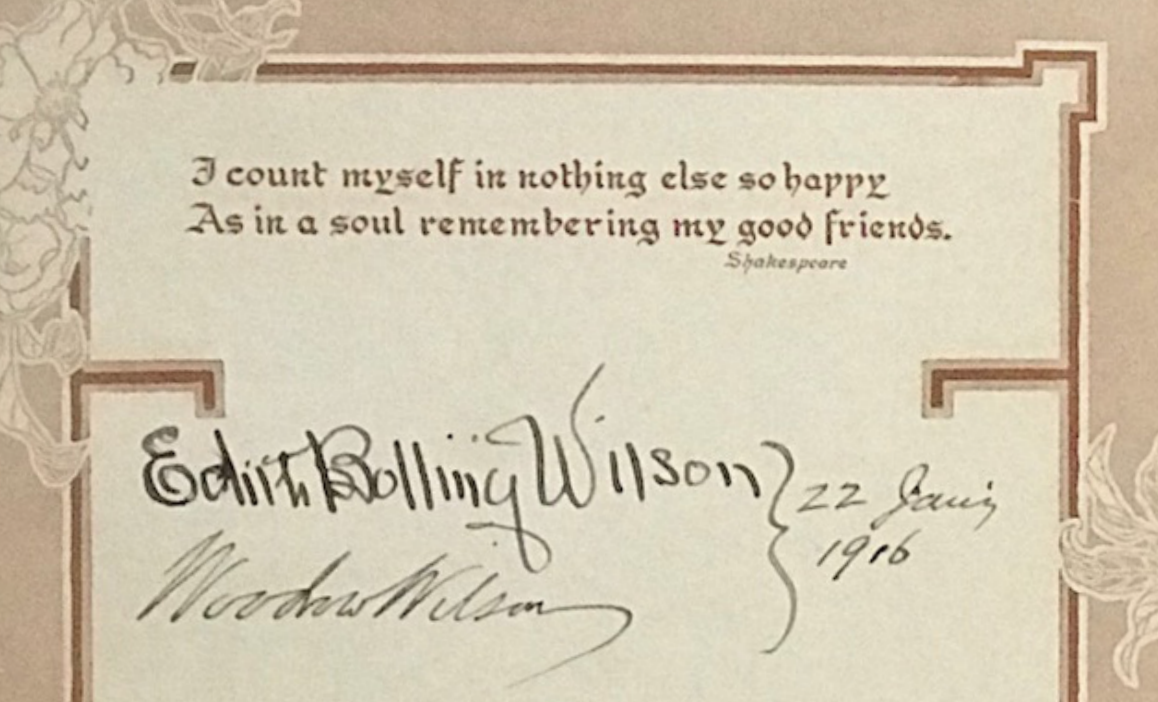 Edith and Woodrow Wilson's signatures, January 22, 1916. Image courtesy of the Yorktown Preservation Society.
Edith and Woodrow Wilson's signatures, January 22, 1916. Image courtesy of the Yorktown Preservation Society.Newly-weds President Woodrow Wilson (1856-1924) and his wife, Edith Bolling Wilson (1872-1961), signed their names on January 22, 1916. Wilson visited Yorktown a number of times during his two terms as president, but this particular visit is not documented in any newspapers or archive. Following a well-documented visit by Wilson on July 3, 1913, York County Clerk of Court, T. T. Hudgins, noted that he knew the president liked to travel incognito, which Hudgins accommodated when Wilson visited the clerk's office.[iii]
After the end of World War I, Wilson attended the Paris Peace Conference and contracted the flu with symptoms beginning on April 3, 1919, amidst the second wave of the disease. He suddenly found it difficult to breathe, and his temperature reached a high of 103 degrees. He told his physician, William & Mary graduate Admiral Cary T. Grayson, class of 1898, “I am feeling terribly bad.”[iv] Grayson recognized the severity of the condition but reported to the press only that Wilson “had a cold.” Wilson soon became so obviously weak and disoriented that some scholars think his judgment and acumen in negotiating the terms of the German surrender were incalculably compromised. Wilson's chief usher said, “One thing is certain: he was never the same after this little spell of sickness.”[v] Wilson suffered a debilitating stroke just six months later.
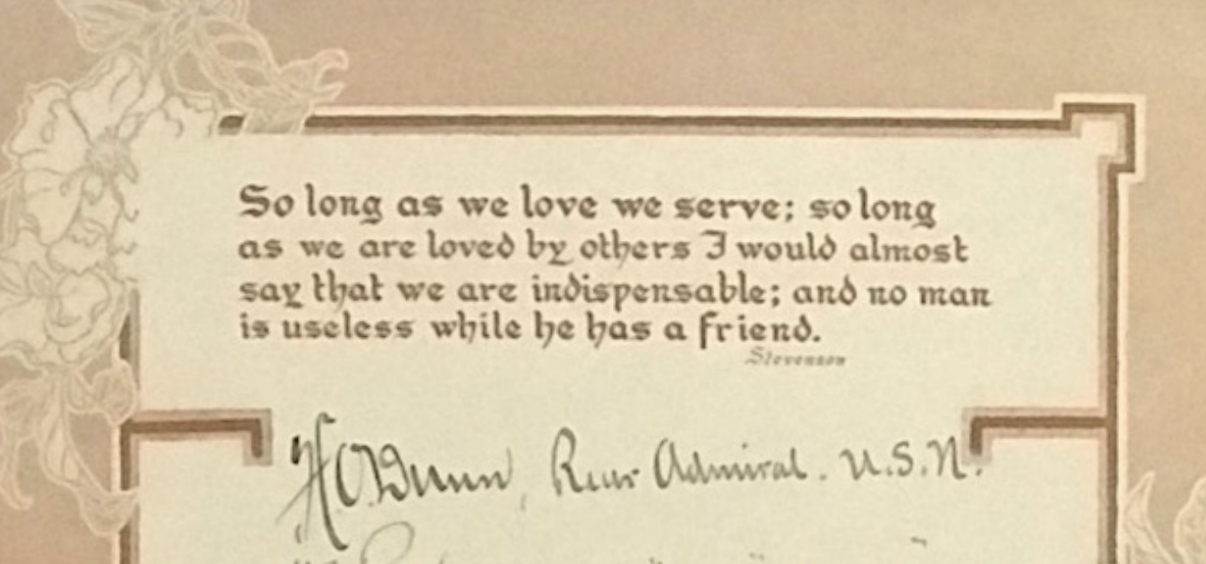 Rear Admiral H. O. Dunn signed Mrs. Sheild's guest book in Spring 1917 before being stationed in the Azores, off the coast of Portugal. Image courtesy of the Yorktown Preservation Society.
Rear Admiral H. O. Dunn signed Mrs. Sheild's guest book in Spring 1917 before being stationed in the Azores, off the coast of Portugal. Image courtesy of the Yorktown Preservation Society.In the spring of 1917, Rear Admiral H. O. Dunn (1857-1939) visited the Sheild home and signed its guest book along with a large cadre of naval officers. Shortly after his visit to Yorktown, he was appointed the first commander of U.S. naval forces stationed at the U.S. Naval Base at the city of Ponta Delgada in the Portuguese Azores. His prompt effectual actions prevented many deaths when the flu epidemic visited the island, killing over 2,000 people out of a population of about 250,000. To honor Dunn’s achievements, the Republic of Portugal awarded him the Order of Aviz in 1918.
Assistant Secretary of the Navy Franklin D. Roosevelt (1882-1945) visited the Sheild home and signed the guest book on July 21, 1917. Lucy Mercer, with two travel companions, signed on the same day on a different page.
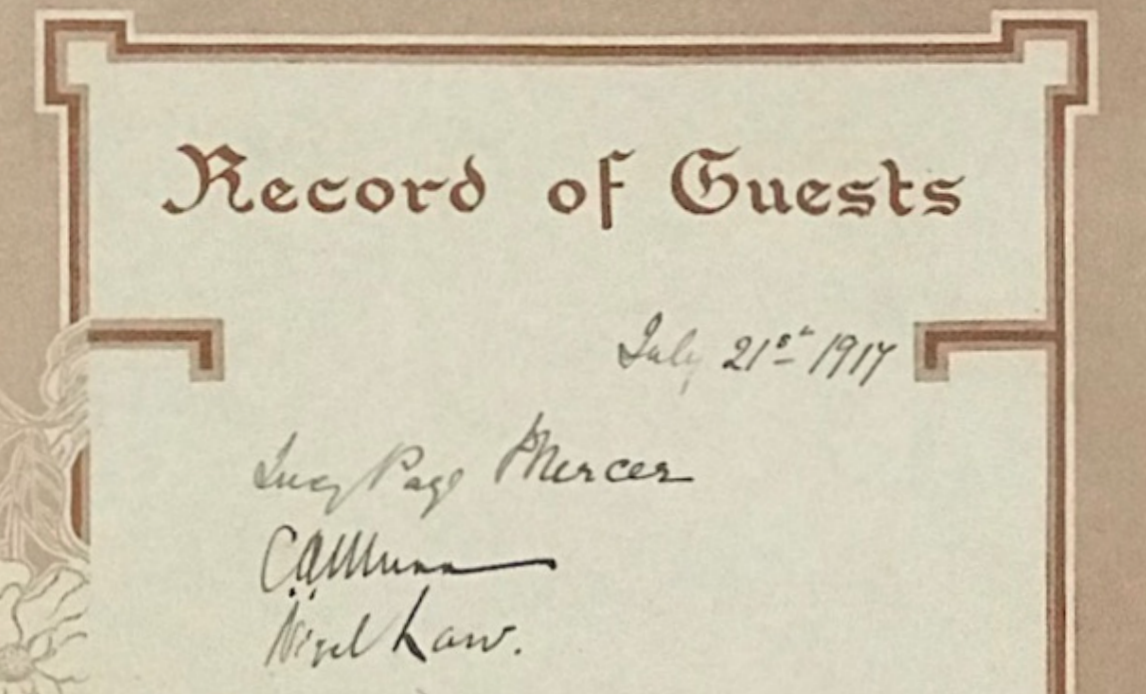 Lucy Page Mercer, along with two other travel companions, signed their names in Mrs. Sheild's guest book on July 21, 1917. Image courtesy of the Yorktown Preservation Society.
Lucy Page Mercer, along with two other travel companions, signed their names in Mrs. Sheild's guest book on July 21, 1917. Image courtesy of the Yorktown Preservation Society.In September 1918, Roosevelt was carried off the troopship Leviathan by stretcher. He had just inspected U.S. troops in Europe and, either before leaving France or in transit, he came down with influenza. He was deathly ill but recovered over the next weeks at his mother's apartment in Manhattan. His wife, Eleanor, rushed to his side to nurse him back to health. As she was unpacking his suitcase from the Paris trip, she came upon a cache of love letters from Lucy Mercer, her former secretary, to FDR.[vi] This discovery devastated her and led to the couple's estrangement for the rest of their lives, an inadvertent but equally unfortunate casualty of the pandemic.
The members of the Randolph Williams family signed the guest book individually after the end of April 1918. E. Randolph Williams, a founder of the Richmond law firm Hunton & Williams (now Hunton Andrews Kurth), his wife, Maude, their two daughters, their son, and Williams's nephew were in their party.
 Franklin D. Roosevelt's signature, also dated July 21, 1917, but signed on a different page from Mercer's. Image courtesy of the Yorktown Preservation Society.
Franklin D. Roosevelt's signature, also dated July 21, 1917, but signed on a different page from Mercer's. Image courtesy of the Yorktown Preservation Society.The Williamses' son, John Langbourne Williams II (1903-1918), called Jack, was a standout at his high school, the Chamberlayne School, now St. Christopher's. When the flu began to take its grisly toll in Richmond (800 deaths in one month), 15-year-old Jack volunteered through his Boy Scout troop (and against his parents' wishes) to transport sick patients from their homes to John Marshall High School which had been converted into a temporary hospital for whites only.
He wrote to a girlfriend in Baltimore describing his experience:
Mother and Father have just finished blowing me up for working all day yesterday in a big school which the city has turned into an influenza hospital. Hereafter I don’t crave stretcher bearing. You see some awfully sad cases...Spanish ‘flu’ is no respecter of persons and people of all races, nationalities, and walks of life. My ambulance hauled nine people from one family.[vii]
Just days after writing the letter, he contracted the disease and died on October 16, 1918.
In 1928, Jack Williams's parents commissioned a stained-glass window in his memory. The memorial was installed in the sanctuary of the 1845 St. Paul's Episcopal Church where the family were parishioners.[viii] This is one of only two known memorials in the United States to remember and honor the many volunteers and professionals who lost their lives caring for the millions of victims of the influenza pandemic—the other is at the University of Montana.
On October 19, 1921, Charles Evans Hughes (1862-1948) was serving as President Warren Harding's Secretary of State when he and his wife visited the Sheild home with Harding and other members of his cabinet. The group was in Yorktown to attend the 1921 Yorktown Day celebration. Later in the day, the group attended the inauguration of President J.A.C. Chandler at William & Mary. Harding spoke at both events.
Hughes' daughter, 28- year-old Helen, had died 18 months earlier in April 1920 of complications following her bout with the influenza-pneumonia.
On May 17, 1927, Roe Chase (1878-1931) of Anoka, Minnesota, signed the guest book. He was an alumnus of the University of Minnesota and, in 1902, purchased an interest in the Anoka Herald, which he wrote for and edited until his death.
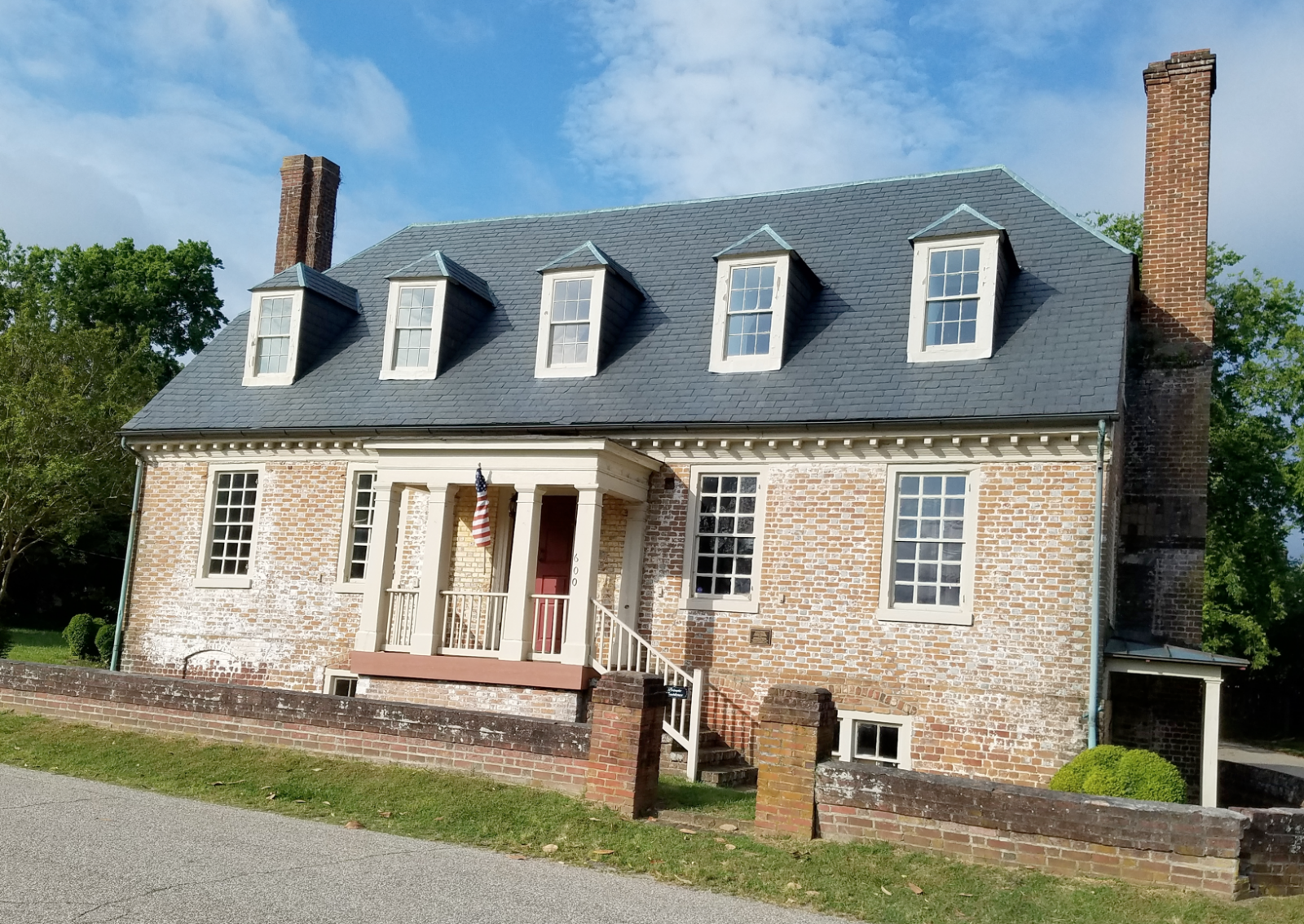 The Sheilds' home, also known as the Sessions-Pope-Sheild House, as it stands today. Image courtesy of the author.
The Sheilds' home, also known as the Sessions-Pope-Sheild House, as it stands today. Image courtesy of the author.In 1918, he volunteered to travel to northern Minnesota to assist in the cleanup following the devastating Cloquet fire. While there, he contracted the flu but fortunately survived. However, the effects of the disease badly damaged his health leaving him so thin that he sent his brother photographs of his emaciated body to corroborate his infirmity. His paper reported that he and his wife spent the winter of 1927 “in the south and Cuba where Mr. Chase went in quest of health.” His visit to Yorktown occurred at the end of his “winter's sojourn,” and his return to Anoka was noted in the May 24 issue of the paper. The article reported that his health had improved and he had gained some weight. Unfortunately, his condition deteriorated, and he passed away four years later at age 53.[ix] His wife managed the paper until its sale in 1960.
The impact of the so-called “Spanish Flu” was felt all over the world. Its importance in the minds of those living through it was diminished by the events around the “Great War,” despite the fact that the estimated number of Americans who died in the war was 115,000 while the number of deaths from flu was over five times greater and estimated at 675,000.
The effects of the “forgotten pandemic” on these and many other families were far greater than those created by the “Great War.”
• • •
Access the completely digitized guest book and learn more about the history of the Sheilds' Yorktown home and its guests from the Yorktown Preservation Society.
Read our April 2020 blog post to discover unique historical resources in Special Collections that document life amidst pandemic, and learn more about how you can share your own personal memories and artifacts of life during COVID-19 with W&M Libraries.
Mr. Cole generously donated an original printing of Harding’s remarks at Yorktown on October 19, 1921 to the SCRC in memory of Margaret Cook.
References:
[i] Sale, Edith Tunis, Interiors of Virginia Houses of Colonial Times, (Richmond, Virginia: W. Byrd Press, 1927), 105. W&M users can temporarily access the full-text of this book online through HathiTrust.
[ii] Coleman, William Caldwell, Robert Henry Coleman: Memoirs of a Brother, (New Haven, Connecticut: Yale University Press, 1919). Access the full-text of this book online through HathiTrust.
[iii] O’Hara, Lucy Hudgins, Yorktown As I Remember, (Verona, Virginia: McClure Print. Co., 1981). See also “Wilson a Stranger in Old Yorktown,” New York Times, July 4, 1913.
[v] Pietrusza, David, 1920: The Year of the Six Presidents, (New York: Hachette, 2006). W&M users can access the full-text of this book online through Ebook Academic Central Complete.
[ix] “Roe G. Chase, Anoka Herald Editor, Dies,” The Brainerd Daily Dispatch (Brainerd, Minnesota), January 13, 1931. W&M users can access this issue of The Brainerd Daily Dispatch, as well as earlier issues of the Anoka Herald, through the Newspapers.com database.